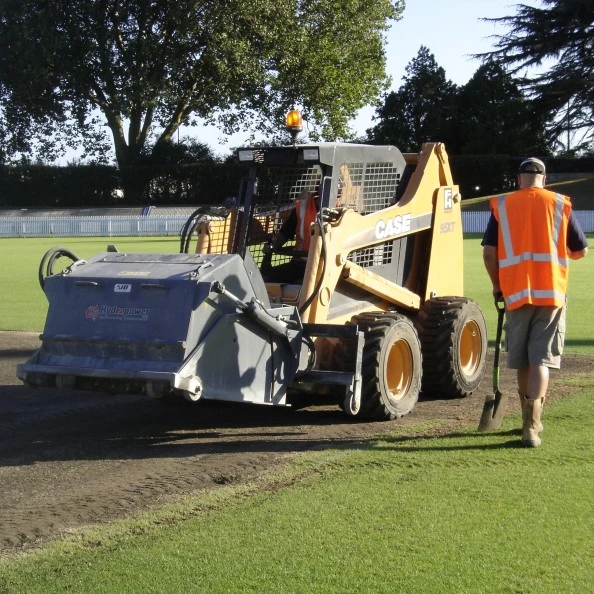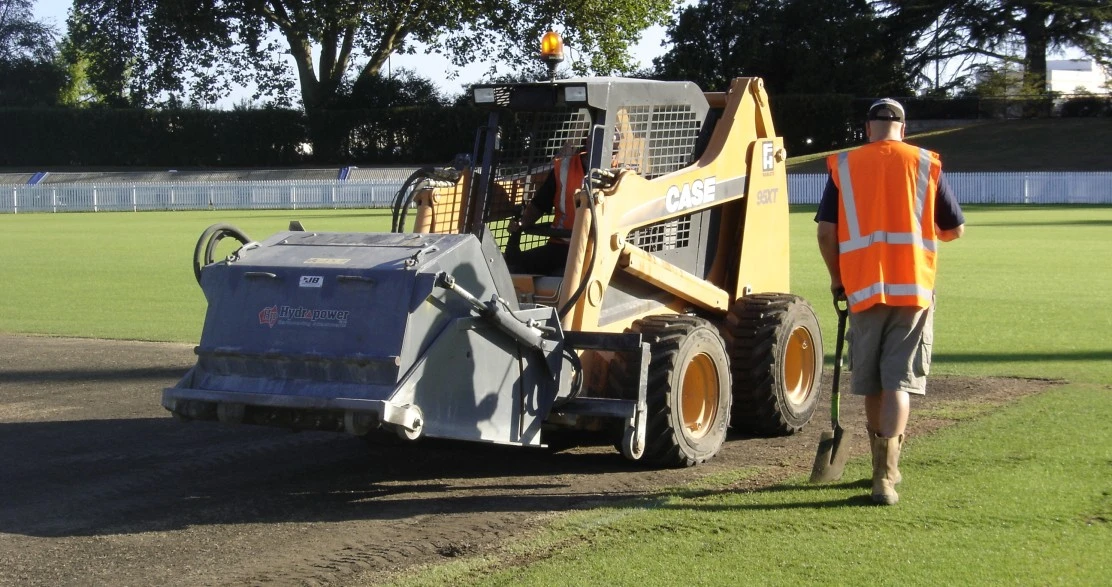Depending on the season it is cared for by between two and five passionate qualified and practiced turf management specialists.
Seddon Park uses rye grass for both the outfield and the pitch block. Different cultivars of rye grass are used for the block and outfield as they are exposed to different pressures. The block requires a grass which is resilient as it is exposed to a lot of rolling, covering and irregular watering and still needs to remain presentable.
Seddon Park is a sand based carpet outfield with 1m spaced sand slits, in Autumn the renovations of the outfield and pitch block take place.
The outfield renovation process starts with scarifying using a tractor operated machine with a number of vertical blades commonly known as a scarifier; the scarifier creates a seed bed and removes organic matter by cutting the surface in a number of different directions depending on how aggressive a renovation is needed. This is decided by examining the organic matter content in the sand profile. It is an important process as organic matter build up in the profile results in poor drainage. The field is swept after each direction scarified.
The field is then cored, this is done once again to remove organic matter from the profile, thousands of cores are brought up to the surface and then swept and removed. After this process sand topdressing begins. The amount of sand to top dress the field varies time to time depending on the renovation. The sand gets dragged in to the core holes using a z brush and drag mat.
Seed is then sown into the field using a seed drill or dimple seeder, these are used as they place the seed into the profile and increase the chances of germination. A fertiliser is applied which is high in phosphorous to once again increase the chances of germination.
The pitch block, which measures 28 metres by 30 metres, has a base with similar characteristics to a porous volcanic rock, covered by 150 millimetres of clay. During the renovation process 5-10mm of clay is removed through grooving, this is done in up to ten different directions. Fresh clay is then top dressed and levelled on the block. The complete sward of grass is removed at this time and re-sown to make sure there is a consistent cover for the next season.
During game season Seddon Park will host, on average, 20 games over the course of 30 days of cricket. The pitch block is home to eight first class pitches. Pitch monitoring is done regularly throughout pitch preparation to measure moisture contents, bulk densities and pore-saturations of the pitch. This allows rolling to be done at the most beneficial time which achieves maximum compaction. For each pitch up to 20 hours of rolling can be done with different sized rollers achieving compaction at different depths of the pitch profile. The grass also needs to be managed so it provides a fair contest between bowler and batter. Preparation of the pitch varies greatly between the different formats of cricket played.
The outfield is mown regularly which creates the dense nature of the grass. A fertiliser programme is set up for the field along with an irrigation schedule to ensure it remains healthy. Due to the nature of Hamilton’s climate a strict fungicide plan is stuck to – this minimises the impact of diseases in the humid summer. Patterns are cut into the outfield for aesthetics and allow the groundsman to bring out their creative side.



